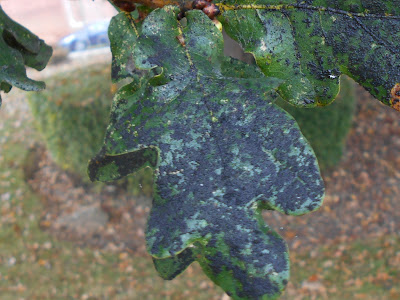Here in the south midlands, and over the south of Britain generally, the commonest Quercus is the Pedunculate Oak, Quercus robur. The word 'pedunculate' refers to the long slender stalk - peduncle - upon which the acorns grow. It is found on deeper, often wettish, neutral to alkaline soils, and is found across Europe to the Caucasus and beyond.
 |
Pedunculate Oak. The acorn is situated on a slender stalk. Kentle
Wood, Daventry. 29 October, 2016
|
 |
The distinctive leaves of Sessile Oak. Windwill Hill, Newnham,
Northants. 31 October, 2016
|
 |
Pedunculate oak showing (top of picture) the lobes at the
leaf base. Daventry, 1 November, 2016
|
 |
Another view of a pedunculate oak leaf showing the lobes
more clearly. Daventry, 1 November, 2016
|
The Turkey Oak, Quercus cerris, can be instantly recognised when in fruit by the long scales on the cup.
 |
Turkey Oak in the grounds of Danetre Hospital, Daventry.
26 October, 2016
|
These scales turn outward and the cup encloses roughly three quarters of the acorn.
 |
| The same tree, showing the acorn... |
When not in fruit the leaves are quite distinctive, being relatively slender with up to ten rather pointed lobes on each side.
 |
| ...and the leaves. |
The Holm Oak, Quercus ilex, is sometimes simply referred to as the Ilex. (Our native holly is Ilex aquifolium and the pretty little Kermes Oak, Quercus coccifera, widespread around the Mediterranean, has rather spiny, holly-like leaves.) The Holm Oak is evergreen and not obviously an oak at all, until its acorns are noticed.
 |
The glossy, evergreen leaves of the Holm Oak are
distinctive. Byfield Pocket Park, 29 October, 2016
|
A small grove of Holm Oak exists at the southern end of Byfield's pocket park and, after a good deal of searching, a couple of the rather small acorns were found.
 |
The acorns of the Holm Oak are rather small. Byfield Pocket Park,
29 October, 2016
|
The tree is quite resistant to salty winds and has often been planted near to the sea. Many woodlands around Sheringham in Norfolk consist largely of Holm Oak and on the Isle of Wight it has become a pest, and a large-scale eradication program is now being undertaken. Incidentally, many of the leaves of the pocket park specimens displayed the mines of the common Garden Midget Moth, Phyllonorycter messaniella. It probably does little harm.
 |
Holm Oak leaves showing the mines of the Garden Midget, a common
moth larva on oaks. Byfield Pocket Park, 29 October, 2016
|
Other exotic oaks may be found in collections from time to time - but I must not allow myself to go beyond the remit I have set myself.
No comments:
Post a Comment